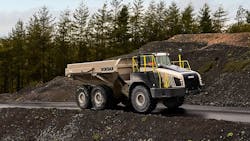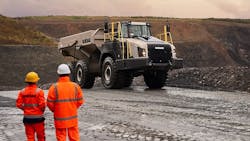How to Spec an Articulated Dump Truck
Articulated hauler trucks efficiently transport heavy loads across challenging terrain and maneuver on tight, tricky sites. Rokbak, a manufacturer of ADTs, suggests five factors help determine what truck aligns with specific needs and operational requirements.
1. ADT capacity and load handling
Assess the application’s typical load capacity and weight to specify the haul truck to handle the demands of the specific job. Consideration of the type and size of material being handled allows the truck’s load-carrying body to be specified correctly to ensure optimum payload, load retention, and longevity. Body options such as side extensions for lighter materials, tailgates for free-flowing material retention, and additional liner plates for highly abrasive or large blasted rocks are all popular choices. Match the hauler to complementary equipment, such as excavators or wheel loaders, to ensure onsite efficiencies and safety.
2. Terrain and site conditions
Articulated haulers are designed to navigate challenging terrain, but the extent of their capabilities can vary. Consider performance in the particular hauling conditions, such as muddy terrain to slippery slopes or various temperature ranges. Evaluate the application and climate, and consider the materials that will be transported. Also look at the topography of the site, including slope gradients, ground conditions, and potential obstacles.
Read also: Technology Targets ADT Roll Overs
3. Fuel efficiency and operating costs
Look at operating costs such as fuel consumption and maintenance. Efficiency in the use of power is as important as having a high-performance truck. An efficient, high-performing engine and responsive transmission shift control are good for low fuel consumption and environmental impact—as well as increased uptime and extended service intervals. An adaptable, perfectly balanced drivetrain provides performance and productivity in all hauling conditions, while meeting worldwide emission standards with low cost of operation. Retardation systems facilitate control of the machine and allow the operator to manage the safety and speed of the hauler—increasing efficiency and reducing wear-and-tear with shorter cycle times on the haul route.
Also look for strong aftersales support, including the availability of spare parts and maintenance services. A well-supported machine will lead to increased uptime and lower operating costs throughout the equipment’s lifecycle.
Read also: Operators Evaluate Doosan ADTs
4. Operator comfort and safety
The well-being of operators leads to efficient implementation of the ADT in its application. Ergonomic design, operator visibility, and the quality of the cabin environment provide a comfortable and safe workspace that not only enhances productivity, but also contributes to employee satisfaction and retention. Haulers equipped with safety features such as stability systems with traction control, body tip inhibits, and advanced braking mechanisms help to ensure a secure working environment.
5. Connectivity
Modern articulated haulers often come equipped with advanced technology and telematics solutions. These features can provide valuable insights into machine performance, fuel efficiency, and maintenance needs—helping machine owners to manage their operating costs.
-Content provided by Rokbak

